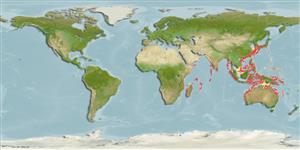Classification / Names
Common names from other countries
Main reference
Size / Weight / Age
Max length : 27.0 cm TL male/unsexed; (Ref. 9824)
Environment
Marine; demersal; depth range 10 - 155 m (Ref. 9824)
Climate / Range
Tropical, preferred ?; 37°N - 32°S, 35°E - 160°E
Distribution
Indo-West Pacific: definitely recorded from Inhambane, Mozambique; throughout the Indian Ocean to Java, Sumatra, Viet Nam, Philippines, Taiwan, South Korea, Japan, and Lord Howe Island (Ref. 9824).
Countries | FAO areas | Ecosystems | Occurrences | Introductions
Short description
Dorsal
spines
(total): 0;
Dorsal
soft rays
(total): 87-97;
Anal
spines: 0;
Anal
soft rays: 61 - 73. Distinguished by cycloid scales on the ocular side, except for upper and lower margins of body, and a shorter lower jaw (2.3 to 2.9 times in head length). Body almost circular in shape in young, becoming ovate with growth.
IUCN Red List Status (Ref. 115185)
Threat to humans
Harmless
Human uses
Fisheries: commercial
More information
ReferencesAquacultureAquaculture profileStrainsGeneticsAllele frequenciesHeritabilityDiseasesProcessingMass conversion
Tools
Special reports
Download XML
Internet sources
Estimates of some properties based on models
Phylogenetic diversity index
PD50 = 0.5000 many relatives (e.g. carps) 0.5 - 2.0 few relatives (e.g. lungfishes)
Trophic Level
3.5 ±0.37 se; Based on food items.
Resilience
Medium, minimum population doubling time 1.4 - 4.4 years (Preliminary K or Fecundity.)
Vulnerability
Moderate vulnerability (36 of 100)
Price category
